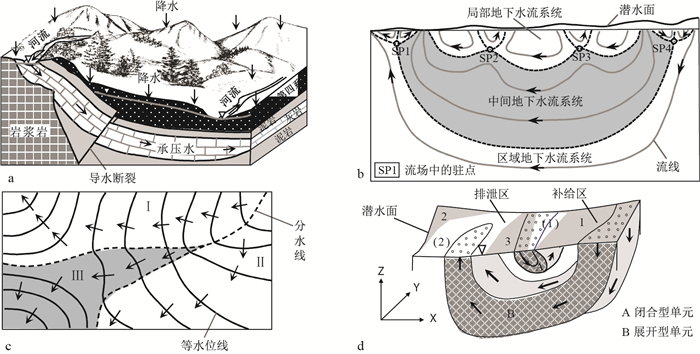| [1] |
沈照理, 刘光亚, 杨成田, 等. 水文地质学[M]. 北京: 科学出版社, 1985.Shen Z L, Liu Y G, Yang C T, et al. Hydrogeology[M]. Beijing: Science Press, 1985(in Chinese).
|
| [2] |
林学钰, 廖资生, 赵勇胜, 等. 现代水文地质学[M]. 北京: 地质出版社, 2005.Lin X Y, Liao Z S, Zhao Y S, et al. Advances in hydrogeology[M]. Beijing: Geological Publishing House, 2005(in Chinese).
|
| [3] |
Duffy C J, Al-Hassan S. Groundwater circulation in a closed desert basin: Topographic scaling and climatic forcing[J]. Water Resources Research, 1988, 24(10): 1675-1688. doi: 10.1029/WR024i010p01675
|
| [4] |
Manning A H, Solomon D K. An integrated environmental tracer approach to characterizing groundwater circulation in a mountain block[J]. Water Resources Research, 2005, 41(12): 1944-1973.
|
| [5] |
Frisbee M D, Tolley D G, Wilson J L. Field estimates of groundwater circulation depths in two mountainous watersheds in the western U.S. and the effect of deep circulation on solute concentrations in streamflow[J]. Water Resources Research, 2017, 53(4): 2693-2715. doi: 10.1002/2016WR019553
|
| [6] |
张宏仁. 地下水水力学的发展[M]. 北京: 地质出版社, 1992.Zhang H R. Development of groundwater hydraulics[M]. Beijing: Geological Publishing House, 1992(in Chinese).
|
| [7] |
Tóth J. A theoretical analysis of groundwater flow in small drainage basins[J]. Journal of Geophysics Research, 1963, 68(16): 4795-4812. doi: 10.1029/JZ068i016p04795
|
| [8] |
张人权, 梁杏, 靳孟贵, 等. 水文地质学基础[M]. 第7版. 北京: 地质出版社, 2018.Zhang R Q, Liang X, Jin M G, et al. Fundamentals of hydrogeology[M]. 7th Edition. Beijing: Geological Publishing House, 2018(in Chinese).
|
| [9] |
梁杏, 张人权, 牛宏, 等. 地下水流系统理论与研究方法的发展[J]. 地质科技情报, 2012, 31(5): 143-151. https://www.cnki.com.cn/Article/CJFDTOTAL-DZKQ201205020.htmLiang X, Zhang R Q, Niu H, et al. Development of the theory and research method of groundwater flow system[J]. Geological Science and Technology Information, 2012, 31(5): 143-151(in Chinese with English abstract). https://www.cnki.com.cn/Article/CJFDTOTAL-DZKQ201205020.htm
|
| [10] |
蒋小伟, 万力, 王旭升. 区域地下水流理论进展[M]. 北京: 地质出版社, 2013.Jiang X W, Wan L, Wang X S. Advances in the theory of regional groundwater flow[M]. Beijing: Geological Publishing House, 2013(in Chinese).
|
| [11] |
梁杏, 张人权, 靳孟贵. 地下水流系统: 理论、应用、调查[M]. 北京: 地质出版社, 2015.Liang X, Zhang R Q, Jin M G. Groundwater flow systems: Theory, application and investigation[M]. Beijing: Geological Publishing House, 2015(in Chinese).
|
| [12] |
McWhorter D B, Sunada D K. Groundwater hydrology and hydraulics[M]. Fort Collins: Water Resources Publications, 1977: 24-53.
|
| [13] |
Bear J. Hydraulics of groundwater[M]. New York: McGraw-Hill, 1979.
|
| [14] |
薛禹群, 吴吉春. 地下水动力学[M]. 第3版. 北京: 地质出版社, 2010.Xue Y Q, Wu J C. Groundwater hydraulics[M]. 3th Edition. Beijing: Geological Publishing House, 2010(in Chinese).
|
| [15] |
陈崇希, 林敏, 成建梅. 地下水动力学[M]. 第5版. 北京: 地质出版社, 2011.Chen C X, Lin M, Cheng J M. Groundwater hydraulics[M]. 5th Edition. Beijing: Geological Publishing House, 2011(in Chinese).
|
| [16] |
王旭升, 万力. 地下水运动方程[M]. 北京: 地质出版社, 2011.Wang X S, Wan L. Equations of groundwater hydraulics[M]. Beijing: Geological Publishing House, 2011(in Chinese).
|
| [17] |
Wang X S, Wan Li, Jiang X W, et al. Identifying three-dimensional nested groundwater flow systems in a Tóthian basin[J]. Advances in Water Resources, 2017, 108: 139-156. doi: 10.1016/j.advwatres.2017.07.016
|
| [18] |
Engelen G B, Kloosterman F H. Hydrological systems analysis: Methods and applications[M]. Dordrecht: Kluwer Academic Publishers, 1996.
|
| [19] |
水利部水利水电规划设计总院. 中国水资源及其开发利用调查评价[M]. 北京: 中国水利水电出版社, 2004.General Institute of Water Resources and Hydropower Planning and Design, Ministry of Water Resources. Investigation and assessment on water resources and its exploitation and utilization in China[M]. Beijing: China Water Power Press, 2004(in Chinese).
|
| [20] |
Somers L D, McKenzie J M. A review of groundwater in high mountain environments[J]. WIREs Water, 2020, 7: 1-27.
|
| [21] |
Bear J. Dynamics of fluids in porous media[M]. New York: Elsevier, 1972.
|
| [22] |
Hubbert M K. The theory of ground-water motion[J]. Journal of Geology, 1940, 48: 785-944. doi: 10.1086/624930
|
| [23] |
Han P F, Wang X S, Wan Li, et al. The exact groundwater divide on water table between two rivers: A fundamental model investigation[J]. Water, 2019, 11(4): 1-10.
|
| [24] |
Li R, Wang X S. Analytical investigation of the exact groundwater divide between rivers beyond the Dupuit- Forchheimer approximation[J]. Hydrological Processes, 2021, 35: 1-16. doi: 10.1002/hyp.13809
|
| [25] |
Freeze R A, Witherspoon P A. Theoretical analysis of regional groundwater flow: 2. Effect of water-table configuration and subsurface permeability variation[J]. Water Resources Research, 1967, 3(2): 623-634. doi: 10.1029/WR003i002p00623
|
| [26] |
万力, 蒋小伟, 王旭升. 含水层的一种普遍规律: 渗透系数随深度衰减[J]. 高校地质学报, 2010, 16(1): 7-12. doi: 10.3969/j.issn.1006-7493.2010.01.002Wan L, Jiang X W, Wang X S. A common regularity of aquifers: The decay in hydraulic conductivity with depth[J]. Geological Journal of China Universities, 2010, 16(1): 7-12(in Chinese with English abstract). doi: 10.3969/j.issn.1006-7493.2010.01.002
|
| [27] |
Jiang X W, Wang X S, Wan L. Semi-empirical equations for the systematic decrease in permeability with depth in porous and fractured media[J]. Hydrogeology Journal, 2010, 18(4): 839-850. doi: 10.1007/s10040-010-0575-3
|
| [28] |
Kuang X, Jiao J J. An integrated permeability-depth model for Earth's crust[J]. Geophysical Research Letters, 2014, 41(21): 7539-7545. doi: 10.1002/2014GL061999
|
| [29] |
Jiang X W, Wan L, Wang X S, et al. Effect of exponential decay in hydraulic conductivity with depth on regional groundwater flow[J]. Geophysical Research Letters, 2009, 36(24): 1-4.
|
| [30] |
Jiang X W, Wang X S, Wan L, et al. An analytical study on stagnation points in nested flow systems in basins with depth-decaying hydraulic conductivity[J]. Water Resources Research, 2011, 47(1): 1-16.
|
| [31] |
Wang X S, Jiang X W, Wan L, et al. A new analytical solution of topography-driven flow in a drainage basin with depth-dependent anisotropy of permeability[J], Water Resources Research, 2011, 47(9): 1-5.
|
| [32] |
Liang X, Liu Y, Jin M G, et al. Direct observation of complex Tóthian groundwater flow systems in the laboratory[J]. Hydrological Processes, 2010, 24: 3568-3573. doi: 10.1002/hyp.7758
|
| [33] |
梁杏, 牛宏, 张人权, 等. 盆地地下水流模式及其转化与控制因素[J]. 地球科学: 中国地质大学学报, 2012, 37(2): 269-273. https://www.cnki.com.cn/Article/CJFDTOTAL-DQKX201202011.htmLiang X, Niu H, Zhang R Q, et al. Basinal groundwater flow patterns and their transformation and dominant factors[J]. Earth Science: Journal of China University of Geosciences, 2012, 37(2): 269-273(in Chinese with English abstract). https://www.cnki.com.cn/Article/CJFDTOTAL-DQKX201202011.htm
|
| [34] |
Liang X, Quan D, Jin M G, et al. Numerical simulation of groundwater flow patterns using flux as upper boundary[J]. Hydrological Processes, 2013, 27: 3475-3483. doi: 10.1002/hyp.9477
|
| [35] |
Wang J Z, Jiang X W, Wan L, et al. An analytical study on groundwater flow in drainage basins with horizontal wells[J]. Hydrogeology Journal, 2014, 22(7): 1625-1638. doi: 10.1007/s10040-014-1146-9
|
| [36] |
Vandenberg A. Regional groundwater motion in response to an oscillating water table[J]. Journal of Hydrology, 1980, 47: 333-348. doi: 10.1016/0022-1694(80)90102-X
|
| [37] |
Zhao K Y, Jiang X W, Wang X S, et al. An analytical study on nested flow systems in a Tóthian Basin with a periodically changing water table[J]. Journal of Hydrology, 2018, 556: 813-823. doi: 10.1016/j.jhydrol.2016.09.051
|
| [38] |
Dai X, Xie Y, Simmons C T, et al. Understanding topography-driven groundwater flow using fully-coupled surface-water and groundwater modeling[J]. Journal of Hydrology, 2021, 594: 1-12.
|
| [39] |
张人权, 梁杏, 靳孟贵. 末次盛冰期以来河北平原第四系地下水流系统的演变[J]. 地学前缘, 2013, 20(3): 217-226. https://www.cnki.com.cn/Article/CJFDTOTAL-DXQY201303026.htmZhang R Q, Liang X, Jin M G. The evolution of groundwater flow systems in Quaternary of the Hebei Plain since the Last Glacial Maximum[J]. Geoscience Frontiers, 2013, 20(3): 217-226(in Chinese with English abstract). https://www.cnki.com.cn/Article/CJFDTOTAL-DXQY201303026.htm
|
| [40] |
Wörman A, Packman A I, Marklund L, et al. Exact three-dimensional spectral solution to surface-groundwater interactions with arbitrary surface topography[J]. Geophysical Research Letters, 2006, 33(7): 1-4.
|
| [41] |
Marklund L, Wörman A. The use of spectral analysis-based exact solutions to characterize topography-controlled groundwater flow[J]. Hydrogeology Journal, 2011, 19(8): 1531-1543. doi: 10.1007/s10040-011-0768-4
|
| [42] |
Wang J Z, Jiang X W, Zhang Z Y, et al. An analytical study on three-dimensional versus two-dimensional water table-induced flow patterns in a Tóthian basin[J]. Hydrological Processes, 2017, 31: 4006-4018. doi: 10.1002/hyp.11317
|
| [43] |
Winter T C. Numerical simulation of steady state three-dimensional groundwater flow near lakes[J]. Water Resources Research, 1978, 14(2): 245-254. doi: 10.1029/WR014i002p00245
|
| [44] |
周鹏宇, 蒋小伟, 万力, 等. 三维Tóth型盆地的驻线及其对多级次水流系统的控制[J]. 地质科技通报, 2022, 41(1): 203-208. doi: 10.19509/j.cnki.dzkq.2021.0017Zhou P Y, Jiang X W, Wan L, et al. Stagnation lines and its control of nested groundwater flow systems in three-dimensional Tóthian basins[J]. Bulletin of Geological Science and Technology, 2022, 41(1): 203-208(in Chinese with English abstract). doi: 10.19509/j.cnki.dzkq.2021.0017
|
| [45] |
Zijl W. Numerical simulations based on stream functions and velocities in three-dimensional groundwater flow[J]. Journal of Hydrology, 1986, 85(3/4): 349-365.
|
| [46] |
Zijl W, Brouwer G K, Waardenburg F D E, et al. FLOSA: A tool for regional three-dimensional flow systems analysis[C]//Jousma G, Bear J, Haimes Y Y, et al. Groundwater contamination: Use of models in decision-making. Amsterdam: Springer Netherlands, 1989.
|
| [47] |
Haitjema H M. On the residence time distribution in idealized groundwater sheds[J]. Journal of Hydrology, 1995, 172(1/4): 127-146.
|
| [48] |
Wörman A, Packman A I, Marklund L, et al. Fractal topography and subsurface water flows from fluvial bedforms to the continental shield[J]. Geophysical Research Letters, 2007, 34(7): 1-5.
|
| [49] |
Basu N B, Jindal P, Schilling K E, et al. Evaluation of analytical and numerical approaches for the estimation of groundwater travel time distribution[J]. Journal of Hydrology, 2012, 475: 65-73. doi: 10.1016/j.jhydrol.2012.08.052
|
| [50] |
Goderniaux P, Davy P, Bresciani E, et al. Partitioning a regional groundwater flow system into shallow local and deepregional flow compartments[J]. Water Resources Research, 2013, 49(4): 2274-2286. doi: 10.1002/wrcr.20186
|
| [51] |
Wang J Z, Wörman A, Etienne B, et al. On the use of late-time peaks of residence time distributions for the characterization of hierarchically nested groundwater flow systems[J]. Journal of Hydrology, 2016, 543: 47-58. doi: 10.1016/j.jhydrol.2016.04.034
|
| [52] |
Tóth J. Groundwater as a geologic agent: An overview of the causes, processes, and manifestations[J]. Hydrogeology Journal, 1999, 7(1): 1-14. doi: 10.1007/s100400050176
|
| [53] |
约瑟夫·托特. 重力驱动地下水流系统理论及其应用[M]. 张人权, 梁杏, 靳孟贵, 等译. 北京: 地质出版社, 2015.Tóth J. Gravitational systems of groundwater flow: Theory, evaluation, utilization[M]. Zhang R Q, Liang X, Jin M G, et al. (Trans. )Beijing: Geological Publishing House, 2015(in Chinese).
|
| [54] |
Jiang X W, Wan L, Cardenas M B, et al. Simultaneous rejuvenation and aging of groundwater in basins due to depth-decaying hydraulic conductivity and porosity[J]. Geophysical Research Letters, 2010, 37(5): 1-4.
|
| [55] |
Jiang X W, Wan L, Ge S, et al. A quantitative study on accumulation of age mass around stagnation points in nested flow systems[J]. Water Resources Research, 2012, 48(12): 1-14.
|
| [56] |
Zhang J, Wang X S, Yin L, et al. Inflection points on groundwater age and geochemical profiles along wellbores light up hierarchically nested flow systems[J]. Geophysical Research Letters, 2021, 48(16): e2020GL092337.
|
| [57] |
Gleeson T, Manning A H. Regional groundwater flow in mountainous terrain: Three-dimensional simulations of topographic and hydrogeologic controls[J]. Water Resources Research, 2008, 44: 1-16.
|
| [58] |
Genereux D P, Jordan M T, Carbonell D. A paired-watershed budget study to quantify interbasin groundwater flow in a lowland rain forest, Costa Rica[J]. Water Resources Research, 2005, 41(4): 1-17.
|
| [59] |
Bouaziz L, Weerts A, Schellekens J, et al. Redressing the balance: Quantifying net intercatchment groundwater flows[J]. Hydrology & Earth System Sciences, 2018, 22: 6415-6434.
|
| [60] |
Fan Y. Are catchments leaky?[J]. WIREs Water, 2019, 6: 1-25.
|
| [61] |
梁杏, 张婧玮, 蓝坤, 等. 江汉平原地下水化学特征及水流系统分析[J]. 地质科技通报, 2020, 39(1): 21-33. doi: 10.19509/j.cnki.dzkq.2020.0103Liang X, Zhang J W, Lan K, et al. Hydrochemical characteristics of groundwater and analysis of groundwater flow systems in Jianghan Plain[J]. Bulletin of Geological Science and Technology, 2020, 39(1): 21-33(in Chinese with English abstract). doi: 10.19509/j.cnki.dzkq.2020.0103
|





 下载:
下载:








